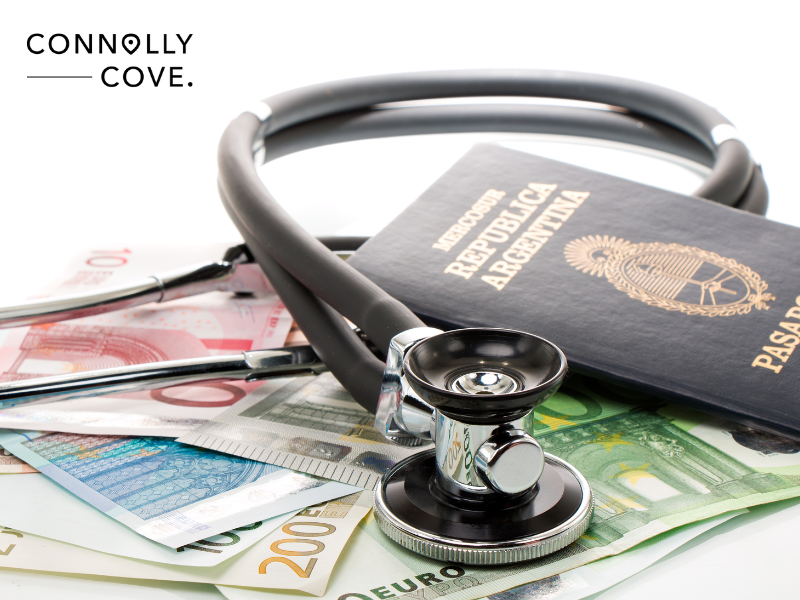Key Insights: Global Medical Tourism Statistics and Market Growth Analysis

Updated On: April 26, 2024 by Raghda Elsabbagh
Exploring medical tourism statistics can feel rather like navigating a twisting maze with a relentless cascade of evolving information and shifting data. We’ve found ourselves grappling to fathom the magnitude of this extensive marketplace and its wide-reaching implications for global healthcare patterns. However, by digesting the freshest stats and growth assessments out there in this sector, we’re able to present to you a lucid viewpoint on where it’s headed in future.

As the field of medical tourism continues to evolve, it presents both opportunities and challenges for healthcare providers, policymakers, and patients. Understanding the dynamics, trends, and implications of medical tourism is crucial for assessing its impact on global healthcare systems and patient outcomes. In this essay, we will delve deeper into the statistical aspects of medical tourism to gain insights into its scale, growth, and implications for healthcare delivery worldwide. So ready yourself for an enlightening journey as we untangle some intriguing truths about this industry worth billions!
Table of Contents
Understanding Medical Tourism: Definition and Overview
A new travel trend is reshaping international tourism like never before, medical tourism. We realise this may not conjure images of traditional backpacking adventures or lavish holidays. But bear with us—the reality is far more intriguing than you might expect.
Medical tourism refers to the practice of travelling to another country to receive medical treatment or procedures. This phenomenon has gained significant traction in recent years due to several factors, including rising healthcare costs in developed countries, advancements in medical technology, and increased accessibility to information about healthcare options globally.
And let us tell you, the size of this sector isn’t a small change: in 2022 alone, the worldwide healthcare market was estimated at a staggering USD 115.6 billion and projected growth looks set to rocket over the next decade.
By spinning crucial health procedures into destination healthcare experiences, we’re witnessing an extraordinary crossroads between patient mobility and international patient travel statistics. It’s a truly original method of taking care of our well-being while also feeding our innate yearning to explore new horizons!
Reasons for Medical Tourism: Factors that Drive People to Travel Abroad for Treatment

The decision to engage in medical tourism is influenced by a combination of factors that can vary widely among individuals. Some of the primary reasons behind the growth of medical tourism include:
Cost Savings: One of the most compelling reasons for medical tourism is the potential for significant cost savings. Patients often find that the cost of medical procedures, including surgeries and specialised treatments, can be substantially lower in certain destinations compared to their home countries. This is particularly attractive for individuals without adequate health insurance coverage or facing high out-of-pocket expenses domestically.
Access to Specialised Procedures and Advanced Technologies: Medical tourists often seek treatments and cutting-edge procedures that may not be available or easily accessible in their home countries, ensuring better outcomes and quality of care. This includes advanced surgeries, experimental treatments, or specialised therapies that are offered by medical facilities abroad with specific expertise in those areas.
Quality of Care: Many medical tourists are drawn to countries known for their high standards of medical care and advanced technology. Receiving treatment from internationally recognised medical professionals or renowned healthcare institutions can provide reassurance regarding the quality and effectiveness of the care received.
Shorter Wait Times: In countries with public healthcare systems that experience long wait times for certain procedures, medical tourism offers an opportunity to bypass these delays. Patients can often schedule treatments abroad more quickly, reducing the time spent waiting for critical medical interventions.
Privacy and Confidentiality: Some individuals choose medical tourism for reasons related to privacy and confidentiality. Seeking treatment abroad can provide a level of anonymity that may be preferred, especially for cosmetic procedures or treatments associated with stigmatised conditions.
Combining Healthcare with Travel: For many, medical tourism is seen as an opportunity to combine necessary medical care with travel experiences. Patients often view medical trips as “health vacations,” allowing them to recover in a relaxing or exotic setting while undergoing necessary medical procedures and receiving treatment. Canny globetrotters are also increasingly combining their passion for discovering fresh cultures with meeting their health necessities.
Lack of Insurance Coverage: In regions where certain medical procedures are not covered by health insurance or where insurance premiums are prohibitively expensive, medical tourism becomes a viable alternative for accessing needed healthcare services.
Understanding these factors illuminates the diverse motivations behind medical tourism and underscores the complex interplay of economic, logistical, and personal considerations that drive individuals to seek healthcare solutions beyond their national borders.
Most Common Medical Procedures in Medical Tourism

Medical tourism encompasses a wide range of medical procedures, spanning from elective surgeries and routine treatments to specialised surgeries and more complex treatments. The popularity of specific procedures can vary depending on the destination and the healthcare expertise offered. Some of the most common medical procedures sought through medical tourism include:
Cosmetic Surgery: Cosmetic procedures, such as breast augmentation, liposuction, facelifts, and rhinoplasty, are among the most popular treatments for medical tourists. Countries like Thailand, Brazil, and Mexico are well-known for offering high-quality cosmetic surgery services at competitive prices.
Dental Procedures: Dental care is a significant component of medical tourism, with patients travelling abroad for services like dental implants, crowns, veneers, and teeth whitening. Dental tourism hotspots include countries like Hungary, Mexico, and India, where skilled dentists provide cost-effective dental treatments.
Wellness Packages: Wellness tourism is on the rise, with individuals seeking relaxation and rejuvenation through spa treatments, yoga retreats, or holistic therapies.
Orthopaedic Surgeries: Joint replacements, spinal surgeries, and orthopaedic procedures are common reasons for medical travel, especially for patients seeking relief from chronic joint pain or mobility issues. Destinations like India, Malaysia, and Singapore are renowned for their orthopaedic specialists and state-of-the-art facilities.
Cardiac Treatments: Patients requiring cardiac surgeries, such as coronary artery bypass grafting (CABG), angioplasty, or heart valve replacements, often consider medical tourism to access high-quality cardiac care without the lengthy wait times experienced in some countries.
Fertility Treatments: Fertility clinics offering in vitro fertilization (IVF), egg donation, and surrogacy services attract patients seeking reproductive assistance. Countries like Spain, Greece, and the Czech Republic are popular choices for fertility tourism due to favourable legal frameworks and advanced reproductive technologies.
Bariatric (Weight Loss) Surgery: Individuals struggling with obesity may opt for bariatric surgery abroad, including procedures like gastric sleeve, gastric bypass, or laparoscopic adjustable gastric banding (LAGB). Mexico, Turkey, and India are prominent destinations for weight loss surgeries.
Ophthalmic Procedures: Eye surgeries such as LASIK, cataract removal, and refractive lens exchange are frequently sought by medical tourists looking to correct vision impairments or reduce dependency on glasses and contact lenses.
Cancer Treatments: Some patients seek medical tourism for cancer treatments, including chemotherapy, radiation therapy, and surgical oncology. Leading cancer centres in countries like the United States, Germany, and Thailand cater to international patients seeking advanced cancer care.
These procedures represent a snapshot of the diverse medical treatments available through medical tourism. The choice of procedure often depends on the patient’s healthcare needs, budget considerations, and the reputation of healthcare providers in specific destinations. As medical tourism continues to evolve, the spectrum of available treatments is likely to expand, offering patients greater flexibility and options for accessing quality healthcare services globally.
Emerging and Established Medical Tourism Markets
Emerging and established medical tourism markets offer diverse options for travellers seeking healthcare abroad. These markets provide a range of treatments, procedures, and destinations to cater to various needs and preferences.
In recent years, emerging markets such as India, Thailand, Mexico, and Turkey have gained popularity in the medical tourism industry. These countries offer high-quality healthcare services at affordable prices, attracting patients from around the world. They boast well-equipped facilities and highly skilled medical professionals who specialise in a wide range of treatments, including cosmetic surgery, dental procedures, wellness programs, and more.
On the other hand, established markets like Singapore, South Korea, Malaysia, and Costa Rica have long been recognised as leading destinations for medical tourism. These countries are known for their advanced healthcare infrastructure and expertise in complex procedures like organ transplants or specialised surgeries.
Key Insights: Global Medical Tourism Statistics and Market Growth Analysis
The global medical tourism market is projected to experience a significant boom, driven by a confluence of factors, such as cost savings and international accreditation. Here’s a breakdown of key insights gleaned from global medical tourism statistics and market growth analysis:
Market Size
The global medical tourism market is growing rapidly. Estimates for the global medical tourism market in 2022 range from $84.92 billion (Source: Mordor Intelligence) to $115.6 billion (Source: Precedence Research). This highlights the substantial size of the industry, with both figures reflecting significant growth in recent years.
Growth Projections
The projected growth rate for the medical tourism market is equally impressive. Here’s a range of forecasts from various sources:
- Fortune Business Insights: Projects the market to reach $93.38 billion by 2030, with a CAGR of 21.3% from 2023 to 2030.
- Mordor Intelligence: Forecasts a CAGR of 23.03% from 2024 to 2029, with the market reaching $239.37 billion by 2029.
These projections indicate a robust and consistent growth trajectory for the medical tourism market in the coming years.
Regional Variations: It’s important to note that growth is expected to vary across regions. The Asia Pacific region is currently dominant, with estimates suggesting a market share exceeding 75% in 2021 [Source: Transparency Market Research]. This dominance is likely to continue due to factors like advanced medical facilities, cost-effectiveness, and a focus on medical tourism infrastructure. However, regions like EMEA (Europe, Middle East, and Africa) are also expected to witness significant growth, with a projected CAGR of 12.2% from 2022 to 2031 (Transparency Market Research). This growth is attributed to factors like rising disposable incomes and government investments in healthcare facilities.
Understanding the market size, growth projections, and regional variations will give you a deeper insight into the dynamic nature of the global medical tourism industry.
Patient Motivations
While cost savings remain a factor, motivations for medical tourism extend beyond affordability. Studies suggest that 40% of patients seek advanced procedures and highly-trained specialists, while 32% prioritise better patient care and attention [Source: Hospital CMQ]. Additionally, shorter waiting times (15%) and access to cutting-edge treatments (13%) are significant motivators.
Top Countries for Medical Tourism
Top countries for medical tourism include Thailand, India, Mexico, Malaysia, and Turkey. Thailand consistently ranks high due to its well-developed infrastructure, high-quality facilities, and relatively lower costs. It offers a wide range of treatments, from cosmetic surgery to dental procedures. [Source: Global Healthcare Accreditation].
India offers a broad range of treatments and highly skilled doctors at a fraction of the cost compared to Western countries, attracting patients for specialities like cardiology, cancer care, and orthopaedics. Mexico is also gaining popularity among medical tourists, especially for dental treatments and cosmetic surgeries. Malaysia provides excellent healthcare services combined with beautiful tourist attractions, making it an attractive option for medical travellers. Finally, Turkey is emerging as a hub for hair transplants and other aesthetic procedures due to its skilled surgeons and competitive prices.

When it comes to choosing a country for medical tourism, it’s essential to consider factors such as the reputation of healthcare providers, affordability of treatment, language accessibility, travel convenience, and post-treatment care options.
Economic Impact
Medical tourism fosters significant economic benefits for host countries. It injects foreign currency, stimulates job creation in healthcare and related sectors (tourism, hospitality), and boosts infrastructure development.
Potential Cost Savings Statistics

The potential cost savings in medical tourism are significant. For example, dental procedures in countries like Mexico or Hungary can be up to 70% less expensive than in the United States or Australia.
Similarly, cosmetic surgery treatments in South Korea or Brazil often come at a fraction of the price compared to Western countries. These lower costs allow patients from all walks of life to seek niche healthcare experiences abroad.
Moreover, potential savings extend beyond just procedure costs; they also include other related expenses such as accommodation and transportation. Patients have the flexibility to choose from various package options that include both treatment and travel arrangements tailored to fit their preferences and budgets.
Impact of International Accreditation
International accreditation plays a crucial role in the field of medical tourism. Accreditation ensures that healthcare providers meet internationally recognised standards and guidelines, giving patients confidence in the quality of care they will receive.
When choosing a destination for medical treatment, it’s important to look for accredited facilities as independent bodies have evaluated them for their safety and quality measures. This helps to minimise the risks associated with receiving healthcare services abroad. Accredited facilities also provide assurance that healthcare professionals are well-trained and experienced in delivering high-quality care.
By seeking treatment at internationally accredited hospitals or clinics, you can have peace of mind knowing that you will receive safe and reliable healthcare during your medical journey.
Future Outlook on Medical Tourism

The future of medical tourism looks promising, and the market is expected to witness significant continued growth due to factors like rising healthcare costs in developed nations, increasing disposable incomes in developing countries, and advancements in medical technology and travel infrastructure.
Experts estimate that the global medical tourism market will reach a value of USD 239.37 billion by 2029. This means that more people will be travelling abroad for healthcare services, seeking affordable treatments and high-quality care in popular destinations around the world.
With advancements in technology and increasing globalisation, medical tourism is becoming more accessible and convenient for patients. Improved transportation options, telemedicine solutions, and international accreditation bodies are making it easier for individuals to choose their desired destination for medical procedures.
In conclusion, the global medical tourism market is experiencing rapid growth and is projected to continue expanding at an impressive rate. With a range of factors driving people to travel abroad for treatment, it’s no wonder why medical tourism is becoming increasingly popular. As we look ahead, it will be interesting to see how the market evolves and which countries emerge as leaders in this growing industry. As the market expands, ethical considerations, quality standards, and patient safety measures will be paramount for continued success.
FAQs
What does the medical tourism industry growth mean?
Medical tourism industry growth refers to the increase in international patients who travel for healthcare services.
How is the global healthcare travel data helpful?
The global healthcare travel data gives an idea of the size of the international medical travel market and shows trends in health tourism statistics.
Can you explain what a medical tourism expenditure is?
Medical tourism expenditure is the money spent by patients on their healthcare treatment, stay and travels abroad.
What information can we get from a medical tourism market analysis?
A medical tourism market analysis offers insights into patient mobility statistics, the growth rate of the medical travel industry and future market trends.
Is there any link between the healthcare industry and the global patient travel market?
Yes, as part of the larger global healthcare market, changes in the healthcare industry, like costs or quality, play important roles in shaping global patients’ choice to participate in Medical Tourism.






